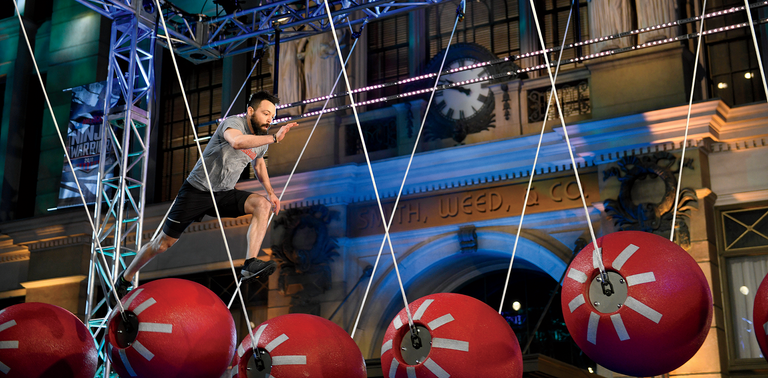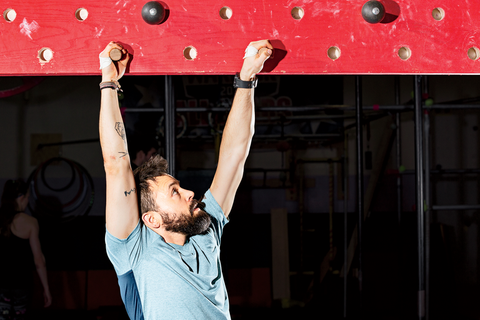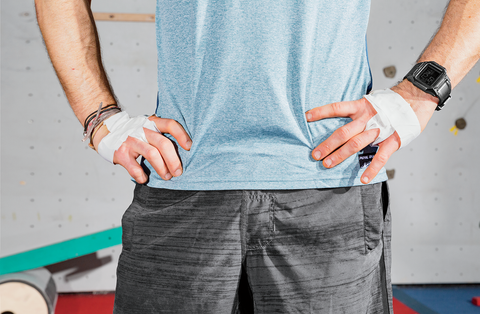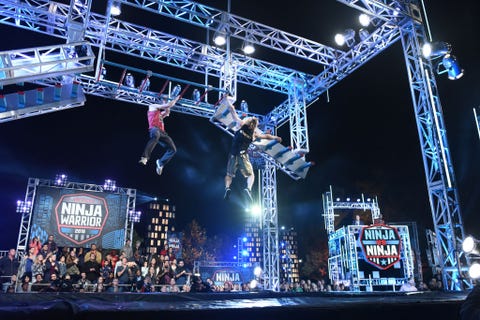
Whenever I close my eyes, I can still see those big red balls swinging above me.
Screw those orbs. They’ve bucked many into the cold waters below, but I thought I would be different.
But let’s back up. A month before these visions, I met Drew Drechsel, an elite ninja trainer, to prep for a qualifying run on American Ninja Warrior, which launched its 10th season on May 30 on NBC (8 p.m. ET/PT). The show reaches 7 million viewers a week. It has two hosts, a sideline commentator, and 27 cameras. The season begins with six-obstacle qualifying runs in six cities nationally, and ninja wannabes relentlessly train for these events in specialized gyms and obstacle-laden backyards. So yes, it’s a pretty big deal.
Drechsel, an eight-time qualifier, agreed to guide me through a gauntlet of tests to assess my muscle and balance. So here I am, outside his 5,500-square-foot gym, New Era Ninjas, in Hamden, Connecticut, ready to work. He throws the doors open, revealing towers of scaffolding, aisles of things to swing from, and two gargantuan warped walls. My palms start to sweat. “Don’t be intimidated,” he says.

Over the next two days, Drechsel teaches me to hang from a pegboard, hurl my body across pullup bars, and run up a 14 1/2-foot warped wall. During one critical lesson, he shows me how to cross a gauntlet of foam blocks (called dominoes), a simulation of ANW’s Spinning Bridge, those diabolical big red balls. “Keep your body weight forward, stay light on your toes, and maintain a steady speed,” Drechsel tells me. After a half hour, I’m sprinting over the blocks. This obstacle I can do.
Drechsel tackles these challenges on a daily basis but insists he’s not working out. The ninja philosophy is seductive: You have fun. “I just like to play,” he says. “I come in here not with an idea of ‘I need to do this.’ You should never have to work hard to do something that looks easy.”
Except two days in, it’s not easy for me. My arms are howling in pain, my forearms are swollen, and I can’t straighten my elbows. Maybe I’m not cut out for ninja glory. Thomas Nesser, Ph.D., a professor of kinesiology at Indiana State University, kind of agrees.

The swelling is probably just muscle tissue damage from trying something new, he says. My body may be different than Drechsel’s; I know from a genetic report a few years back that I don’t produce the protein alpha-actinin-3, which is common in the fast-twitch fibers of power athletes. That could explain why I don’t dig gym sessions like this: I’m more of an endurance guy, not a ninja.
But Nesser has another concern: Can I stick with this? “You’re going to be successful in what you enjoy,” he says. Despite the pain and doubt, I think I’m enjoying this swinging and hanging and trampolining around. In one of Drechsel’s open classes, I meet Matt Zeoli, a 53-year-old regular. “What we do in here,” the gym lifer says, “is just fun.”
I’m starting to feel the same way. This isn’t the rote lifting of body weight; it’s teaching me how to move my body more efficiently, to redirect my momentum in midair. I never want to cut a session short. I want more time on the ropes and pegboards. I can’t feel my forearms, but I can feel myself improving.
A Ninja Hits the Course
Fast-forward a month, and I’m standing at the first of six obstacles at Universal Studios in Los Angeles. I’m a special entry into the course; I’m not allowed to make the second round.
Not that I would. I’ve already watched some two dozen people run the course, and not one survived to the end. The first guy, who had python arms, pointed at the sky and screamed, “warped wall, baby!” He fell on the second obstacle.

So I utter no brazen guarantees as I sprint toward my first obstacle, a pair of rotating platforms called Archer Steps. I complete them, leaping out over the water, catching a rope, and swinging forward onto a platform. The crowd erupts.
The crowd is going bananas. I’m Neo from The Matrix. I’m Jackie Fucking Chan.
Now it’s on to the second obstacle, Jumper Cables. I hear Drechsel shout, “Keep your arms long!” I manage to follow his advice, swinging on nunchuck-type handles toward a punching bag on a zip line. I catch the bag and ride it to safety. Two down.
The crowd is going bananas (at least that’s how I remember it). I check my forearms. They should be blazing right now, but the adrenaline cocktail in my bloodstream seems to have given me barbaric strength. I’m Neo from The Matrix. I’m Jackie Fucking Chan.
I’m unstoppable as I step to the third obstacle: the Spinning Bridge. You know how this goes, of course: I get cocky. Halfway across the bridge, my eyes lift to the next platform, where I think I’ll be in two seconds. My foot falls heavy on the ball in front of me. It spins. I’m in the water.
Splash. Game over. I’m not the one after all.
But now I understand why people train year-round for this unforgiving, one-shot course. It’s like a giant adult playground. In the history of American Ninja Warrior, only one person has actually reached the final finish line to earn the $1 million prize.
The winner stopped competing, citing a “lack of desire after already accomplishing my ultimate goal.”
On American Ninja Warrior, failure is its own gift, motivation to keep doing what Drechsel forever refuses to call “training.” It’s the reason that, by this time next year, my forearms will be stronger and my balance better. With luck, I’ll get another crack at this in 2019.
When I do, I’ll be ready.
To watch Clint’s run to American Ninja Warrior glory, tune in to NBC on June 13 at 8 p.m. Eastern. You’ll get an inside look behind the scenes of the Men’s Health feature and a chance to see him take on the course on TV!
Follow the path of the ninja
These moves will build the strength you need for body-weight mastery.

Knee-to-elbow
Start hanging from a bar, hands just slightly beyond shoulder-width, palms facing away. Tighten your core and lift your knees as high as you can; round your back until your knees touch your elbows. Return to the start slowly. Aim for 12, which is the number Drechsel has his students do at the start of each session.
Jump squat
Stand with feet shoulder-width apart. Bend your knees, lowering your torso until your thighs are parallel to the floor. Stand back up explosively, jumping up as you do. Land softly and immediately begin the next rep; do 3 sets of 10.
Uneven grip pullup
Hang from a bar, your hands shoulder-width apart in an uneven grip (right palm facing you, left facing away). Pull yourself up, challenging your core and lats and building the strength needed to hang from anything. Switch your hand placement every set. Once you can do 12 straight reps, try hanging from the bar and switching hand placement every rep.
Quadrupedal crawl
Start on all fours, your arms and legs straight, your body long and low. Crawl forward. Move your right arm and left leg at the same time, and then your left arm and right leg at the same time. Go back and forth like this in the gym for three minutes; do two sets.
Source: Read Full Article
